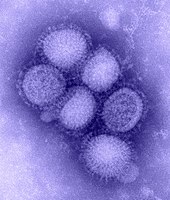
Photo from wikipedia
Although RNA viruses exhibit extensive sequence diversity, the mutation rate must be limited to ensure protein functions that maintain the viral life cycle. Here, we compared the whole genome sequences… Click to show full abstract
Although RNA viruses exhibit extensive sequence diversity, the mutation rate must be limited to ensure protein functions that maintain the viral life cycle. Here, we compared the whole genome sequences of 150 isolates of classical swine fever virus (CSFV), obtained from a single epidemic that occurred in Japan during 2018-2020. After the detection of the first case, the disease spread among both farm pigs and wild boars and caused severe impact on the pig industry. To evaluate the diversification of the CSFV genome that eliminated mutations negatively affecting viral transmission, the substitution sets inherited by at least two isolates were separately evaluated as shared single nucleotide variants (SNVs) or shared single amino acid variants (SAVs). Comparisons of 12 protein-coding regions indicated that the percentages of SNVs and SAVs in the multifunctional nonstructural protein NS3 were the lowest, and shared SAVs were not detected in another nonstructural protein, NS4A. This demonstrated purifying negative selection suppressing changes in the protein sequences of NS3 and NS4A during virus transmission in the field. In contrast, a high possibility of nonsynonymous substitution among shared SNVs was detected only in genes encoding the secreted protein Erns and the nonstructural protein NS2, suggesting positive selection during the epidemic. Mapping of shared SAVs to the three-dimensional structure of Erns revealed that shared SAVs were not present in the substrate-binding sites but were instead localized to the peripheral region of the protein. These data will support efforts toward the development of diagnostic methods, recombinant vaccines, and antiviral agents targeting conserved and indispensable viral genes.
Journal Title: Veterinary microbiology
Year Published: 2021
Link to full text (if available)
Share on Social Media: Sign Up to like & get
recommendations!